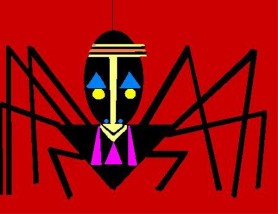Arts On Sunday
In spite of the many erosions, intrusions, dilutions, discouragement and disappearance, contemporary Caribbean societies can celebrate several African cultural forms and social traditions. The focus here is not on the continent of Africa, which has several different nations and cultures, but on forms and traditions which are now known as Caribbean, but which are parts of the African heritage; of traditions that evolved in the region and are now considered as indigenous to it, but which have undisputed Afrogenesis.

Within the folktales of the Caribbean there is a great wealth of oral literature that is varied, interesting and multi-ethnic. The Amerindian tales, for example, carry with them a strong mythological component according to the world picture and beliefs of the people among whom they were created. Where these are concerned there are many comparisons with that branch of Caribbean folktales derived from Africa, but although the stories are well known, they are appreciated as entertainment with little attention paid to the other socio-cultural factors.
The elements of myth and belief are not as strong as in the Amerindian corpus, but some of them are there all the same, and they were important in the origins and evolution of the stories. These African folk tale traditions are known across the range of Caribbean territories, with some countries having their own peculiar forms, but they are all variants of a regional tradition of common origin.
One of the common elements is that they are not just stories, but performance traditions. The ‘Crick Crack’ storytelling performance is an example of this, and it has its variants in different Caribbean countries. It is a group performance in which the ‘audience’ participates and there are close connections between performers and audience to the extent that the two almost become one. It has the African format of a leader and chorus in which the participants are both chorus and audience, participating in elements and parts of the whole storytelling session.
There is a version of this in St Lucia, normally performed in French Creole/Patois. The  ‘leader’ or Conteur announces that a story is about to be told by calling out “Crick !” (“kwik” in patois), to which the audience responds by shouting “Crack !” (“kwak“), thus the utterance “crick crack” is completed. The Conteur then tests the audience with riddles to which they may shout the answer, and since many of the riddles are known a whole session of exchanges will follow. After this the story is told.
‘leader’ or Conteur announces that a story is about to be told by calling out “Crick !” (“kwik” in patois), to which the audience responds by shouting “Crack !” (“kwak“), thus the utterance “crick crack” is completed. The Conteur then tests the audience with riddles to which they may shout the answer, and since many of the riddles are known a whole session of exchanges will follow. After this the story is told.
The audience then becomes a chorus, not only listening to the story, but commenting. The riddles make statements about the environment, the world known to the participants. This will sometimes contain elements of mythology. However, since these traditions are continually suffering erosion, a session like this today is likely to be dominated by jocular type riddles. The folk tales, too, contain a bit less of the mythology for which they have been known.
The Ti Jean tales of St Lucia, are still good examples of the traditional type. Ti Jean is a folk hero, commonly depicted as a teenage boy with exceptional talents. He is a simple village boy hunting or cutting wood in the forest who is remarkable for his wits, quick thinking, and mental agility. These give him the ability to take on and defeat powerful opponents and he very often achieves a victory for good over evil. He protects the environment, animals, the weak and underprivileged and in these functions he has as an ally, the powerful Papa Bois, who is a protector of the forest, conserving and acting against the excesses of greedy hunters.
But Ti Jean also has about him, the very marked trickster characteristics for which the spider Anansi is famous. This is another of the distinct African elements in these folk tale traditions. Some West African cultures have a trickster god, who is often the keeper of a gateway between the earthly mortals and the realm of the ancestors or gods. Eshu plays that role for the Yoruba, and another is known among the Akan from whom the spider Anansi comes. Ti Jean, is, of course, another version of the Anansi figure in Caribbean folktales. This trickster hero is widely known in the African nations. On the continent and in the African diaspora, there are such heroes as the Hare, the Rabbit, Compere Lapin, Brer Rabbit, the Tortoise, Brother Tacuma and, of course, Brer Anansi.
It is said that the Anansi stories in the Caribbean were moral fortifications for the enslaved for whom he served as inspiration and a mythical hero against slavery. Among the Akan he is a demi-god and the spider is known for survival through his wits and for his possession of magical type powers. But Anansi is also given several mortal weaknesses including his own share of excesses, greed and selfishness, making him something of a hero-villain, very much like the trickster/god Eshu. With his mixture of qualities, Anansi is an incorporation of the people themselves.
The corpus of Anansi stories across the Caribbean is enormous. A very important factor is that the same stories are known in many different territories, often with variants and versions. It is the same across the Atlantic, since similar stories known in Africa, have their versions in the Caribbean.
Similarly, the Crick-Crack folktale tradition is known with variants in different Eastern Caribbean countries like Grenada and Trinidad. Even in Jamaica, Anansi stories and other folktales have a ritual ending. The storyteller says “Jack Mandora, me no choose none,” which has been differently interpreted. Generally it is thought to be an appeal to the keeper of the gateway to free the storyteller and his audience of any guilt, or any commission of evil that may have been a part of the story, further testimony to the importance of keepers of gateways and trickster deities.
Always, these stories have great entertainment value, but it is part of the African tradition that have become parts of the fabric of Caribbean society that they have so much social and cultural significance and play roles in the lives of the people well beyond their existence as performance and entertainment.

